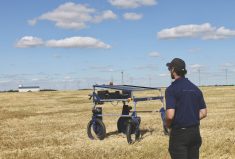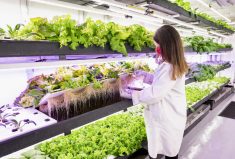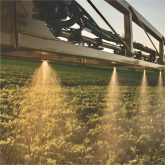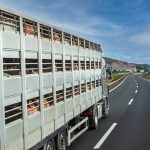Precision ag is such a patchwork today. It seems to offer the potential to achieve so many great things on the farm, yet it can create almost as much bother and anxiety for the grower, i.e. the very individual it was created to help. With the number of systems, designs and platforms that can collect data, variably apply fertilizer or seed, generate maps for spraying, plus a dozen other functions and applications, it’s no wonder some growers are overwhelmed by the offerings.
When it launched a year ago, Climate FieldView was billed as a platform that would simplify the process of aggregating on-farm data generated from planter, sprayer or combine. It was launched in February 2017 in Eastern Canada, with a limited number of growers using it to gather their data and to get a better sense of what exactly they might do with that information.
Read Also

Riding the tariff roller-coaster
What producers are doing to minimize the risk created by ongoing trade uncertainty.
The overall goal with this technology is to simplify, making it easier to access all associated information from one field and then to use the data to make better-informed decisions.
It’s worth noting that since its launch, FieldView now covers more than one million acres in Canada
It’s the simplicity that attracted John Kapteyn, a producer who operates Arbor Lane Farm, a broiler-breeder farm near Barrie, Ont. He has 40,000 hens producing hatching eggs, and together with his wife Tammy, and his parents Cor and Ricki, cash crops about 900 acres of corn, soybeans and wheat. He also provides custom work for a few of his neighbours. Kapteyn actually started using FieldView 2016 as one of the testers of the unit.
“It’s a great platform for capturing all the data at planting and harvest,” says Kapteyn. “Plus you can enter all of the other operations in between, such as fertilizer and spray applications. I find it very valuable — I now have all of my records in one easy place to see.”
Another feature he likes is the Rainfall Report, an app that lets a grower know how much rain falls on a given field. There’s also a function that provides field imagery maps during the course of the growing season to help with scouting. He also used it for a corn seed plot for DeKalb, tracking hybrid changes through the plot, which show up in different colours. At harvest, the system provides individual monitoring of each hybrid.
Asked if he believes there are limitations with the platform — size, complexity of a farm, livestock versus straight cash cropping — Kapteyn doesn’t see any real disadvantage. It will work for all sizes of operation and the current pricing structure is a flat-rate fee, regardless of the number of acres.
“It was very easy to set up an account with the different pieces of equipment for recording operations,” he adds. “I had one problem last fall when my iPad updated to a new version: I called the customer support line and received excellent service from a very knowledgeable representative. They actually had to call me back a couple of times, and they followed through until they knew I had everything running again.”
Sharing of information once it’s gathered is yet another of the benefits promoted by Climate Corporation. For instance, Kapteyn is also satisfied with its ability to share data gathered from his fields with his seed dealer or his fertilizer supplier. In keeping with his custom work, he can also send yield results to his clients.
Many benefits
In the course of the past year of FieldView’s availability, Denise Hockaday, climate commercial lead with Climate Corporation, notes there have been three primary benefits that have “risen to the top” among users. There’s the ease of collecting and navigating through their data, since ease of use promotes learning more about the platform and how to use more of its capabilities. There’s also the system’s “all-in-one-place” feature so growers can see what they want or what they need wherever they are, be it in the tractor, the sprayer or the combine. And there’s also the availability of data and information in real time — no waiting to gather and interpret information. If the grower wants to begin mapping out fertility plans after harvest, they can, without switching out and relaying thumb drives.
At the end of 2016, after the testing stage, one of the things Hockaday remarked on was the kinds of questions she was getting from growers, particularly how to plumb more information out of the platform. They liked the simplicity, they liked the real-time information — and they wanted more.
“That question still remains, and I think it always will because as creatures of ‘the more you know, the more you want to know’ approach, the more data you get into, the more you want to dissect,” says Hockaday. “We still get those questions, especially from those folks who are always driving for more information. They want to drill down and understand the ‘why’ even more.”
For others who haven’t been collecting data or who have been collecting it but not doing anything with it, Hockaday suggests they’re likely making better progress now.
“Some might say, ‘This makes sense for a corn grower,’ yet for the same reason, it makes sense for a soybean or wheat farmer, or an edible bean farmer, or a canola or vegetable farmer,” says Hockaday. “That’s actually some of the feedback we’ve had, is that it’s very versatile and it’s not specific to just one crop.”
One of the questions she’s fielded recently from several non-users is, “Why should I use this?” Beyond the evolutionary aspect of agriculture and the growing prevalence of precision ag systems, Hockaday concedes she has been asked challenging questions. For some farmers, they want the imagery to make it easier, whether that’s for their own interpretations or for scouts and agronomists to identify conditions in-season.
“In another case, it’s a matter of measuring and performance, or the grower wants to check whether a fungicide application paid off or not,” she says. “That’s been very difficult, if not impossible, to do in the past.”
It might also be a challenge that this still isn’t a silver bullet or one-size-fits-all solution. Every customer is unique in the challenges they’re facing and the needs that they have, says Hockaday. It takes a little bit longer to help them understand how the FieldView would work for them.
“For some who’ve been collecting data or actively managing things on their farm, or trying different things, they’ve been doing it for a while, so they’re asking us the questions that push us to the next level,” explains Hockaday. “Then you have the other spectrum of farmers who say, ‘I’ve never collected anything,’ or ‘I’ve collected it and I’ve overwritten it because I’ve never taken anything off the monitor.’ They’ve used it purely as a monitor in the field and never bothered to measure the environmental data or looked at imagery.”
Sometimes the conversations with those individuals can be overwhelming for them. But Hockaday starts right at the beginning, with collecting data. Get that visual representation and then let things begin to evolve.
In the spirit of realizing that learning encourages more learning, the most pleasant surprise in the past year has been how farmers have used the FieldView platform beyond its original training. On their own, they’ve engaged in new methods to generate more information about their fields. From a scouting and functionality perspective, some growers are mapping rocks in the field, or identifying tile drainage issues.
“Those are things that we don’t talk about broadly, but those are things that producers are coming back to us and saying, ‘This makes my life so much easier,’” says Hockaday.
As margins continue to tighten and costs increase, the challenge before growers is to maximize their efficiency, and Hockaday hears talk along those lines. Growers are saying they’re not expanding their acreage or that the cost of investment in capital to accommodate growth is not an option. As a result, more growers are increasingly open to the idea of using precision ag, perhaps to improve their efficiency by 10 or 15 per cent versus buying 10 or 15 per cent more land.
Kapteyn also sees an increasing adoption of precision ag. It’s easier to improve on 10 or 15 aspects on a farm by one per cent each, rather than trying to raise efficiency with one facet by 10 or 15 per cent.
“Precision ag will continue to become more prevalent,” says Kapteyn, talking changes coming to Arbor Lane Farm. “As we get more data, the challenge will be how to use it to better our operations. Our next step will be to use our yield data to allow us to use variable planting rates to try to cut our seed costs.”
















